Text

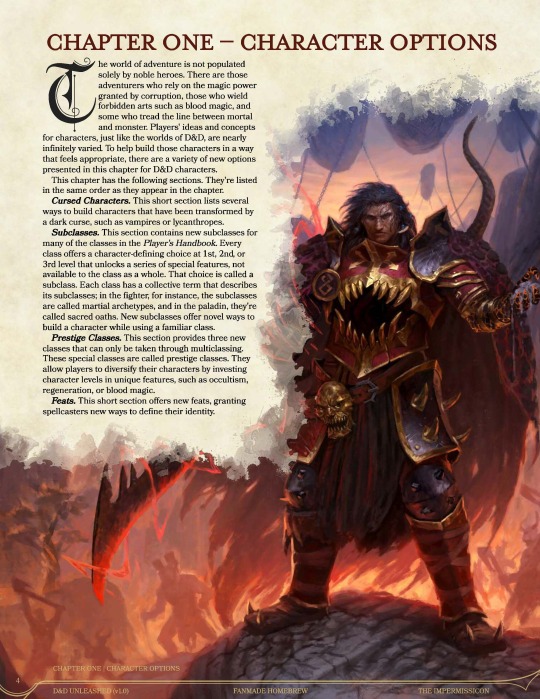
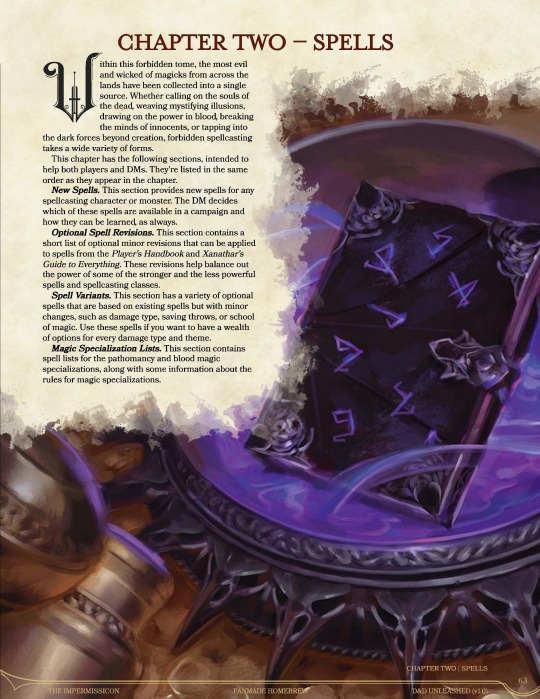
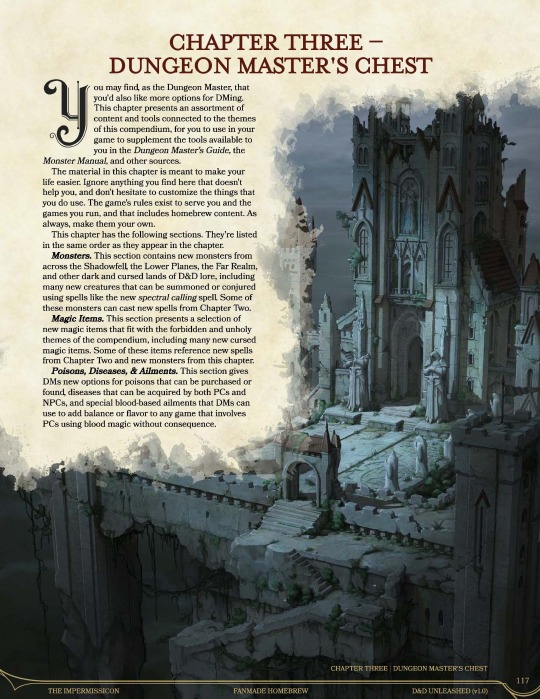
Download Links: Normal PDF, Low-File-Size PDF, High-Definition PDF, Spells Sorted By Level PDF, Full-Size Cover Art Image, Dust Jacket Image
The second and possibly most-anticipated D&D Unleashed compendium of the three, The Impermissicon, has finally released after more than two years of development! This compendium is filled with content related to lycanthropes, vampires, undead, illusions, enchantments, corruption, and blood magic, and you can download it for free right here!
This 254 page compendium contains 24 subclasses, 3 prestige classes, 107 spells, 118 spell variants, 91 monsters, 61 magic items, 24 poisons, 23 diseases, and even more goodies for both players and DMs! See the full article for the release of this compendium here.
83 notes
·
View notes
Text

PDF Link | D&D Beyond Link
It’s just a few weeks before the release of The Impermissicon, but that won’t mark the end of D&D Unleashed. After that, we still have one more compendium to finish, called Legends of Prestige & Prowess. This week, we have a preview of the new bard subclass to appear in that compendium, as a consolation for those bard-lovers who were sad to see no new subclasses in the Table of Contents preview for the upcoming compendium.
For more information on the design of the College of Healing, you can read the rest of the article on our website.
112 notes
·
View notes
Text
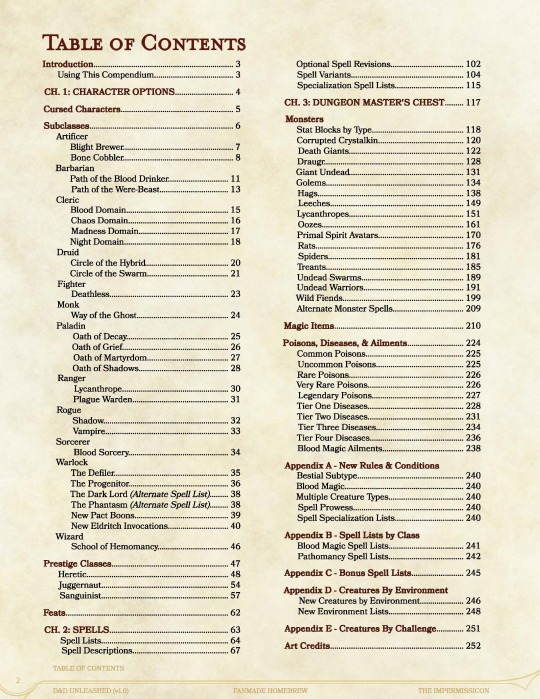
Before the end of August, the official release of The Impermissicon, D&D Unleashed’s second full compendium, will be available for download on our website entirely for free. Today we’re showing a special preview of the compendium: the table of contents page!
You can see the full scope of the massive 254-page compendium, including the dozens of subclasses, prestige classes, categories of monsters, and more. If you’re hungry for even more, keep checking this site over the next few weeks or sign up for email updates to know the exact moment when the full compendium is available!
55 notes
·
View notes
Photo
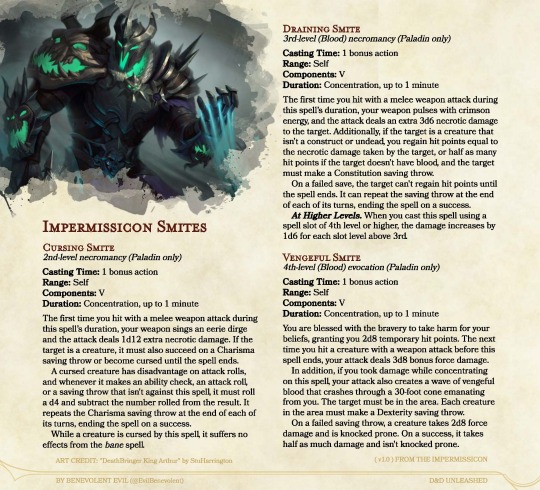
PDF Link | D&D Beyond: Cursing Smite, Draining Smite, Vengeful Smite
With the final touches now being put on The Impermissicon before its public release, we have three new spells to preview from its pages, perfect for your anti-hero paladins and dark oathbreakers alike! Of course, even with these spells, not all the spells from the upcoming compendium have been previewed yet. We’re still saving some surprises for you all, whether you’re interested in spells, subclasses, monsters, or all sorts of other kinds of D&D content!
These three spells are new “Smite” spells for paladins, following the same design principles as the official “Smite” spells, such as blinding smite and staggering smite. Cursing smite carries a debuff similar to the bane spell with additional potency, but only affects one target. Draining smite is designed to be similar to vampiric touch, while vengeful smite uses its own mechanic to determine whether the spell gains extra power or not.
39 notes
·
View notes
Photo
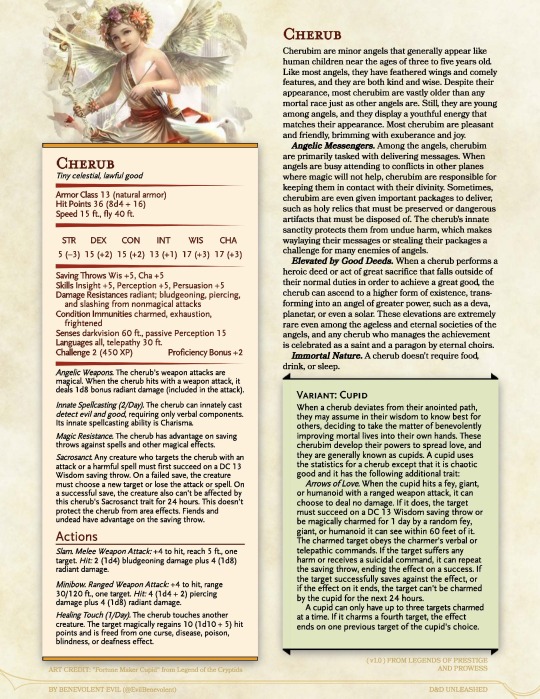
PDF Link | D&D Beyond Link
To go along with the potentially-romantic mood-lighting set by today’s earlier preview, the new moonlight spell, we’ve got a bonus extra preview for today! Cherubim are angels with a low challenge rating, allowing them to feature in campaigns earlier than other angels such as deva or planetar would be able to. They can also be summoned by high-level clerics using the conjure celestial spell, giving them the new and flavorful option of calling upon their god’s own divine messengers for direct aid. And of course, there are the variant cherubim known as cupids, who are perfect for any holiday-themed adventures during this month of February! Cupids join the ranks of medusas, lamias, and pegasus(es) in the “mythological proper names used as the generic term for an entire kind of D&D creature” club.
61 notes
·
View notes
Photo

PDF Link | D&D Beyond: Malady, Vile Miasma
This preview from The Impermissicon focuses on two new disease-based necromancies: a 7th-level spell called malady and a cantrip called vile miasma. Just like the last time you saw some of our disease-themed necromancies, these spells are only useful against targets that can be afflicted with diseases, providing some natural immunity to paladins and anyone else with similar purity of body. Malady is also a blood spell, and much like some of the recent blood magic spells that we’ve previewed, it doesn’t require its targets to have blood but simply gains additional effects against targets that do.
38 notes
·
View notes
Photo



PDF Link | D&D Beyond Links: Bone Golem, Filth Golem, Shadow Golem
We’re getting closer and closer to the release of The Impermissicon, and that means more and more previews! This time we’re looking at the three new kinds of golems introduced in the compendium to go along with fifth edition’s existing clay, flesh, iron, snow, and stone golems: the menacing bone golems, revolting filth golems, and nightmarish shadow golems.
Bone golems make excellent guardians to accompany necromancers, dark cults, death hags, or death giants. Filth golems are commonly created by alchemists, warlocks, yuan-ti, kuo-toa, or any manner of hag. Shadow golems are extremely rare, and usually commanded only by the most powerful of villains, such as liches, demon princes, or evil archpriests, who use shadow golems not only for protection, but also as stand-alone spies, scouts, and assassins.
235 notes
·
View notes
Photo

PDF Link | D&D Beyond Link
We alluded to it in the preview discussing vampiric barbarians, but it’s finally time to preview the Vampire rogue subclass! This homebrew subclass will appear in our next D&D Unleashed compendium, The Impermissicon, as one of two new subclasses for rogues. Because of its regenerative abilities, this rogue is tougher than other subclasses, at least as long as they aren’t exposed to any of their vampiric weaknesses. While vampire barbarians and vampire warlocks are both optional choices available for those subclasses, vampirism is a requirement for this subclass. So what is it about vampiric traits that fits a rogue subclass?
117 notes
·
View notes
Photo
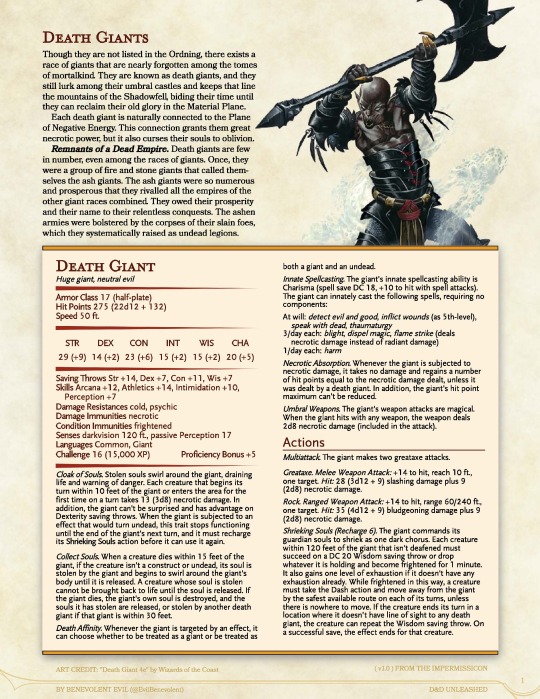


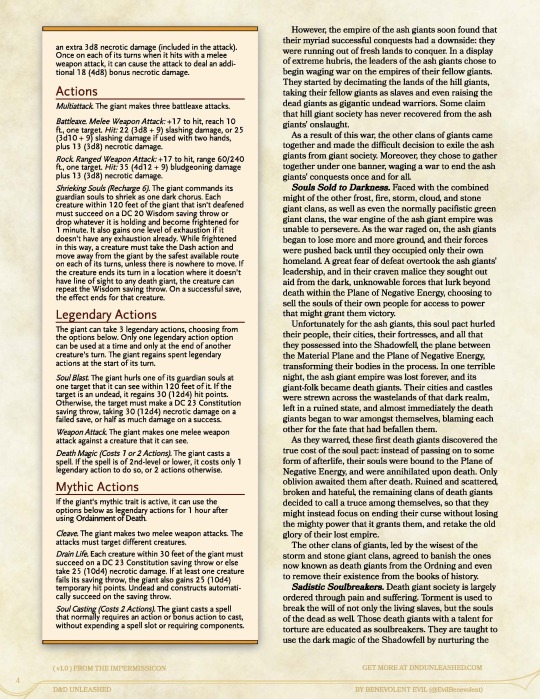

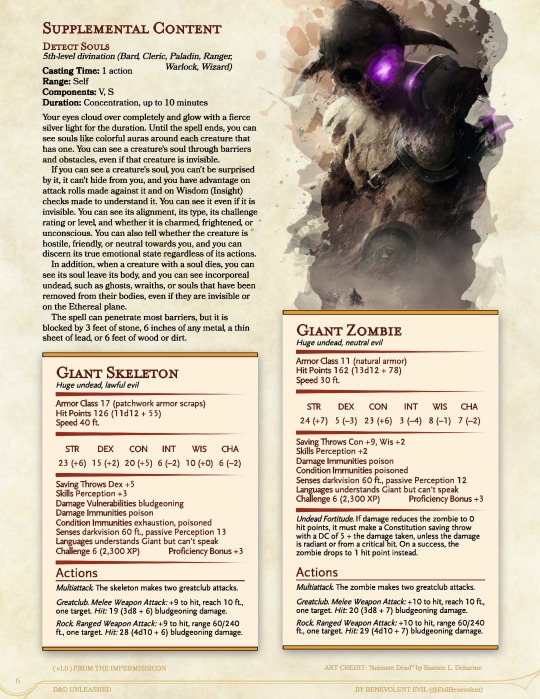
PDF Link | D&D Beyond Links: Death Giant, Death Giant Soulbreaker, Death Giant Bone King, Giant Skeleton, Giant Zombie, Detect Souls
Death giants are designed as an epic-level threat used to populate adventures and campaigns. They are more powerful than the other giants that player characters can face in D&D, and they have a variety of potent abilities that make each rank-and-file death giant a threat even to high level characters. For example, they have innate spells for when weapon attacks don’t work or when ranged damage or area damage is needed. They also threaten semi-permanent death for PCs that can normally resurrect each other with ease, since a death giant can escape with the soul of a slain PC, preventing their resurrection. They can grant themselves immunity to many spells and abilities that don’t work against undead, and their Shrieking Souls ability can easily fragment a party of PCs and change the course of a battle.
A single death giant can be a great addition to a battle with a lich, mummy lord, death knight, death hag, or other necromantic villains, either fighting as a mercenary or defending its own personal interests. A pair of death giants can be a dangerous random encounter for any high-level adventuring group travelling across the planes. However, a DM can also use even more powerful death giants, such as soulbreakers or bone kings, or use the death giants statistics to build custom death giant NPCs, and create an epic-level adventure that consists primarily of battling the death giants and thwarting their ambitions, or interweave such a story with other epic-level undead threats, such as Orcus or one of the classic archliches.
80 notes
·
View notes
Photo
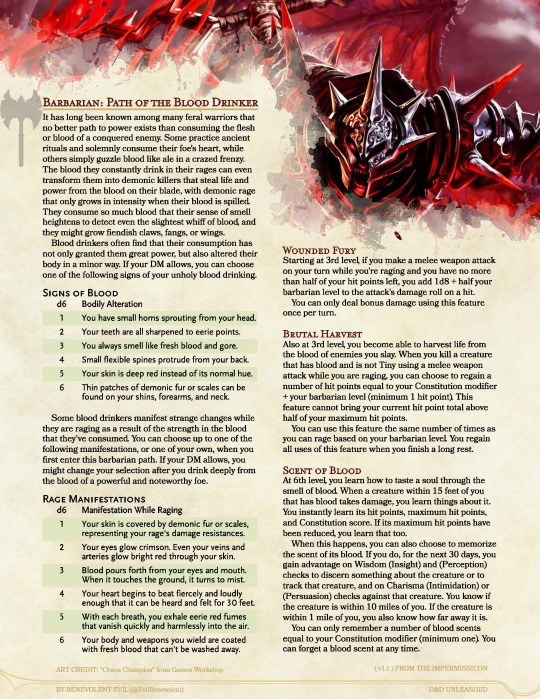
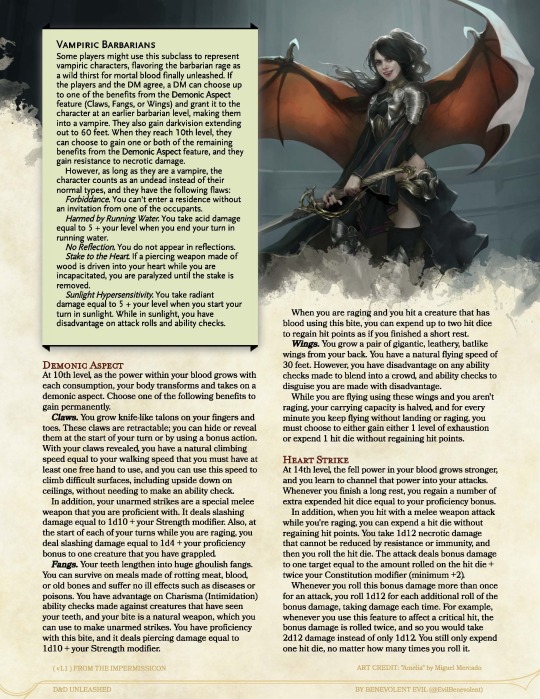
PDF Link | D&D Beyond Link
The subclass now also includes special optional rules for using it to build a vampire barbarian, granting them the Demonic Aspect feature earlier than level 10, but imposing the considerable drawbacks of vampirism upon the barbarian as compensation. This is just one of many options available in the compendium that allows players to build monstrous characters like vampires and werewolves. If this rampaging, blood-crazed barbarian isn’t your vision for your vampire, you could use the Progenitor warlock to create a vampire that leans into its dark magic talents, or even the upcoming dedicated Vampire subclass for rogues.
69 notes
·
View notes
Photo
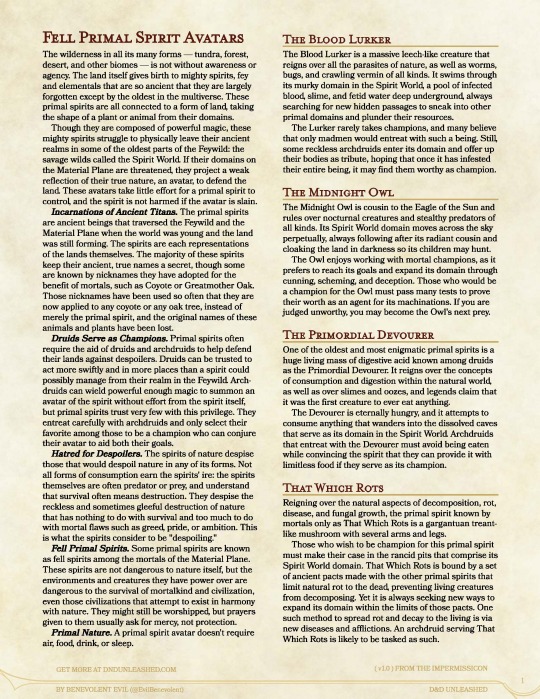
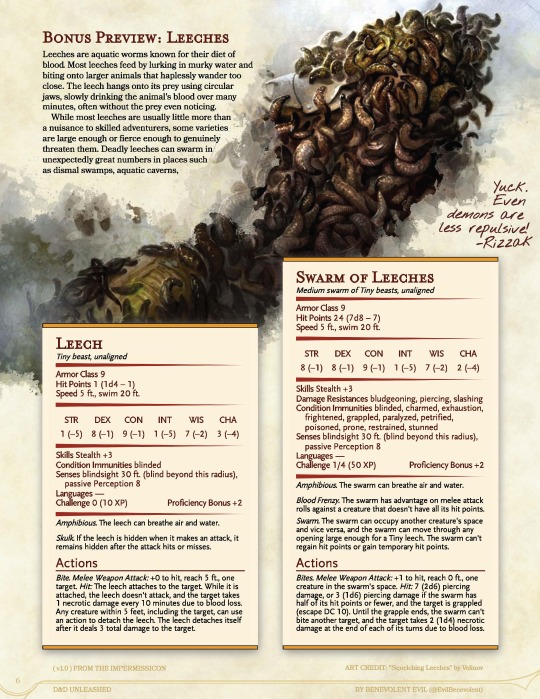

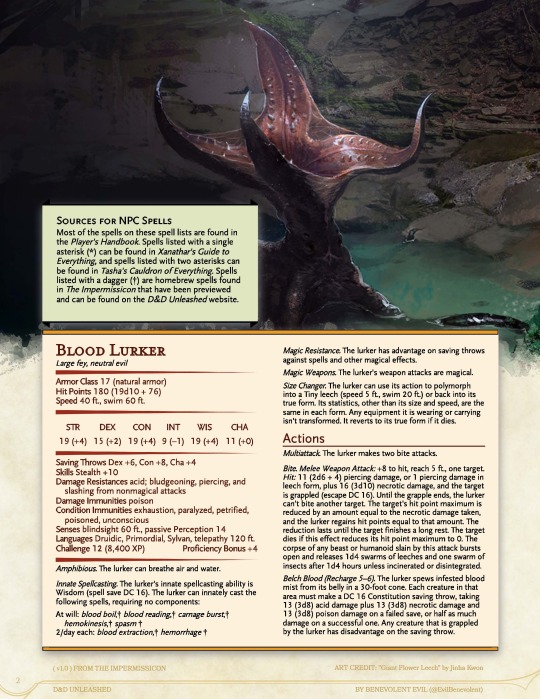


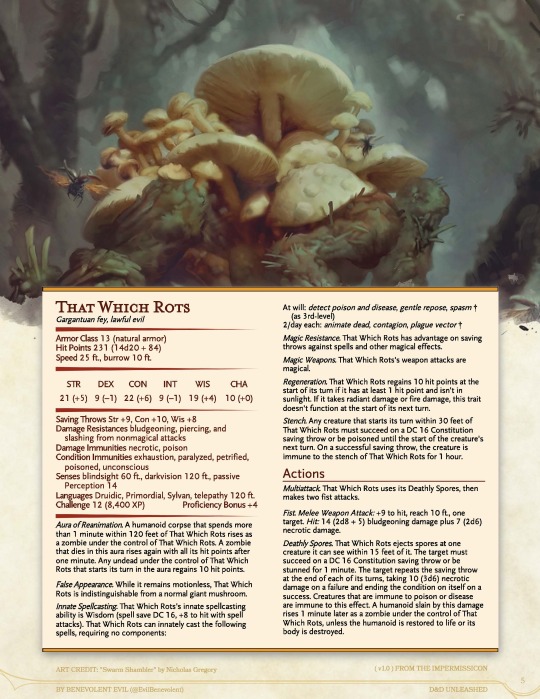
PDF Link | D&D Beyond Links:
Blood Lurker, Midnight Owl, Primordial Devourer, That Which Rots
Leech, Swarm of Leeches, Giant Leech
If you’ve already seen the Primal Spirit Avatars and the summon primal spirit spell from The Elements & Beyond, then this preview from The Impermissicon should already make sense to you. If you still haven’t yet, the spirits and the spell are intended to be used together, but both can be used just as effectively on their own. In this case, each of these spirits (as well as the leeches) can be used perfectly well as monsters in a combat encounter against PCs of the appropriate level. When players do things that may anger the spirits of nature, perhaps those angry spirits appear to remind them to be more careful! But these spirits can also be conjured as temporary allies by druids using summon primal spirit (and a 9th-level spell slot).
49 notes
·
View notes
Photo
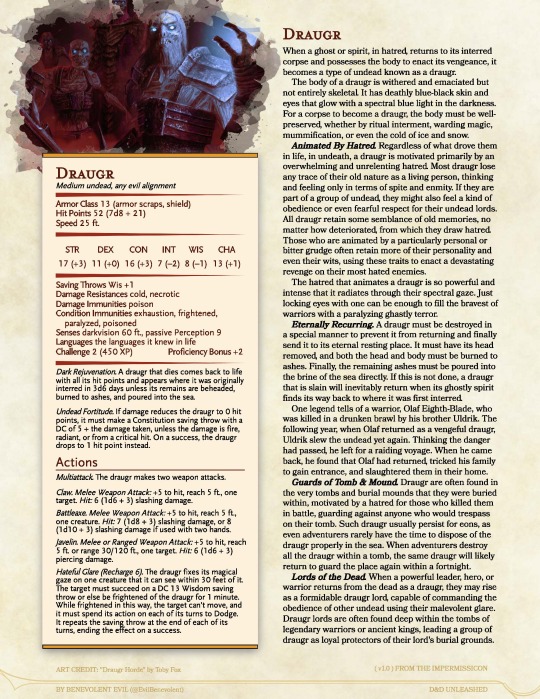
“You can’t run from your past, Uldrik. You can’t run from what you’ve done. You can’t escape me, no matter how many times you murder me.”
PDF Link | D&D Beyond Link
The draugr is a classic fantasy undead from Scandinavian folklore that has seen a resurgence in popularity thanks to video games like Skyrim, God of War, and Valheim. Draugr are more powerful than a simple skeleton or zombie, but the basic draugr is also usually less threatening than a more advanced undead, such as a skeleton knight or zombie berserker. Draugr can be understood as vengeful ghosts that return to possess their own corpses, doing so to seek out revenge or to guard their burial chambers against trespassers. In folklore, many different types of abilities and traits are attributed to draugr, so our rendition draws from the most common and most resonant interpretations and depictions from both folklore and modern works.
If you want the statistics for the draugr lord described at the end of the page (along with its more powerful variant, the icy draugr king), you’ll just have to wait for the full release of The Impermissicon, the compendium of dark magic and forbidden lore that houses these draugr and more homebrew D&D content, planned for the second half of 2022!
59 notes
·
View notes
Photo

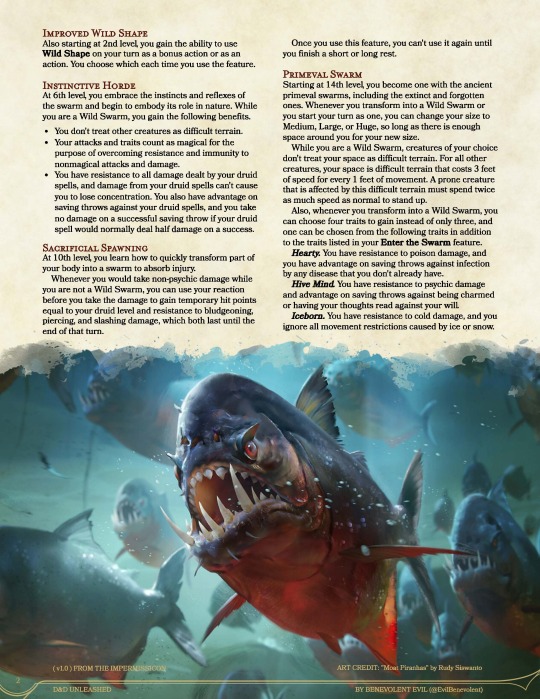
PDF Link | D&D Beyond Link
Sometimes it isn’t enough to transform into a wild animal: you want to become legion, to have your body dissolve into a writhing horde of swarming critters and overwhelm your enemies as a single contiguous mass. Perhaps you’ve been wanting to build a dark elf druid that poisons enemies using swarms of spiders, a kenku shaman that explores the sky as flocks of ravens, or a desert wanderer that combines earth magic with hordes of venomous scarabs and scorpions.
Maybe you miss the flavor and gameplay of the Swarm Druid subclass from 4th edition, or maybe you just want an alternate option to the Moon Druid that still focuses on the power of wild shape. This preview of the Circle of the Swarm, a new homebrew druid subclass for 5th edition D&D that will appear in The Impermissicon, serves all those needs and more!
29 notes
·
View notes
Photo
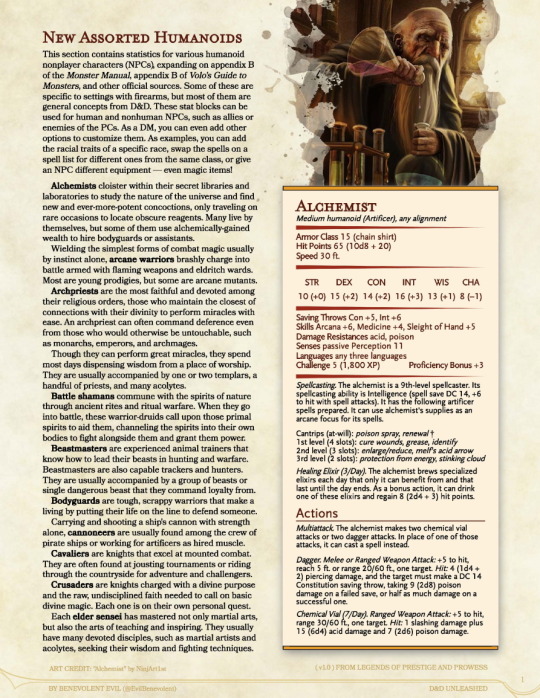
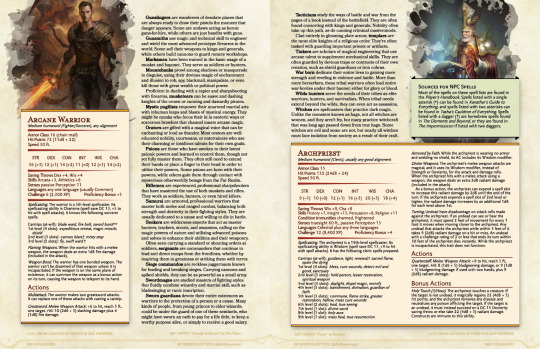
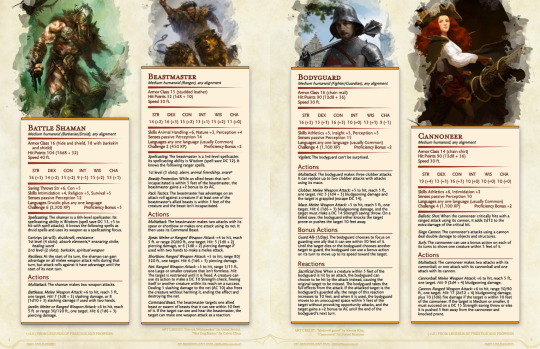
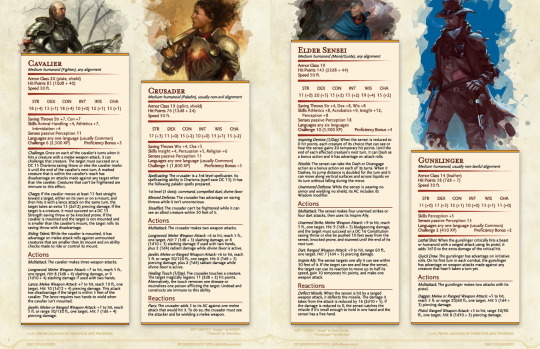


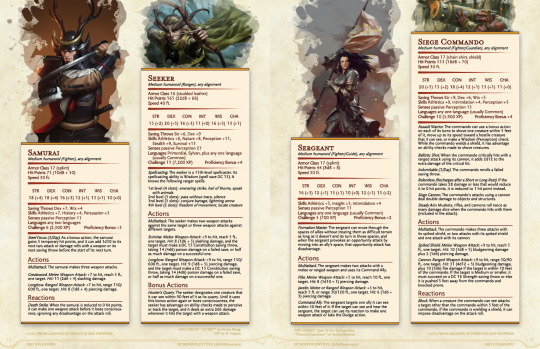
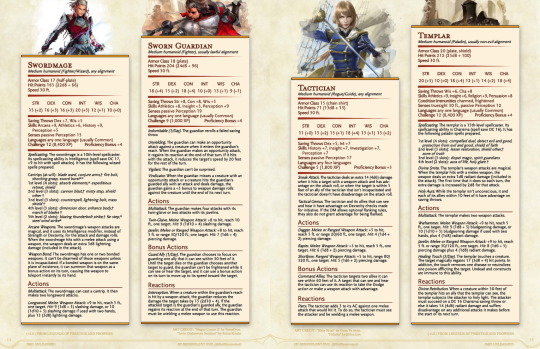
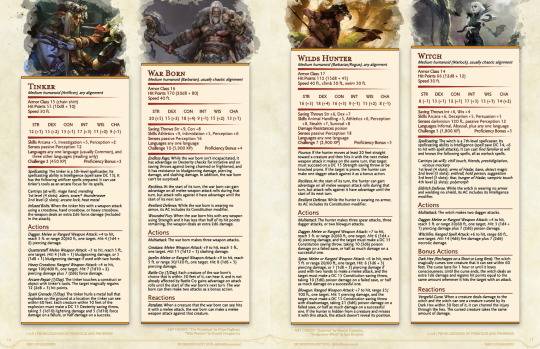
These NPC stat blocks are themed around all of the official D&D classes, plus two of our own prestige classes, the Guardian and the Guide (previously known as The Leader), which will be appearing in their finalized form with these NPCs in the same D&D Unleashed compendium: Legends of Prestige & Prowess. They are intended to be used along with the NPCs from the Monster Manual and Volo’s Guide to Monsters, using the original NPC design for 5th edition.
PDF Link | D&D Beyond Links:
Alchemist, Arcane Warrior, Archpriest, Battle Shaman, Beastmaster, Bodyguard, Cannoneer, Cavalier, Crusader, Elder Sensei, Gunslinger, Gunsmith, Marksman, Mountebank, Musketeer, Mystic Pugilist, Orator, Psion, Rifleman, Samurai, Seeker, Sergeant, Siege Commando, Swordmage, Sworn Guardian, Tactician, Templar, Tinker, War Born, Wilds Hunter, Witch
388 notes
·
View notes
Photo
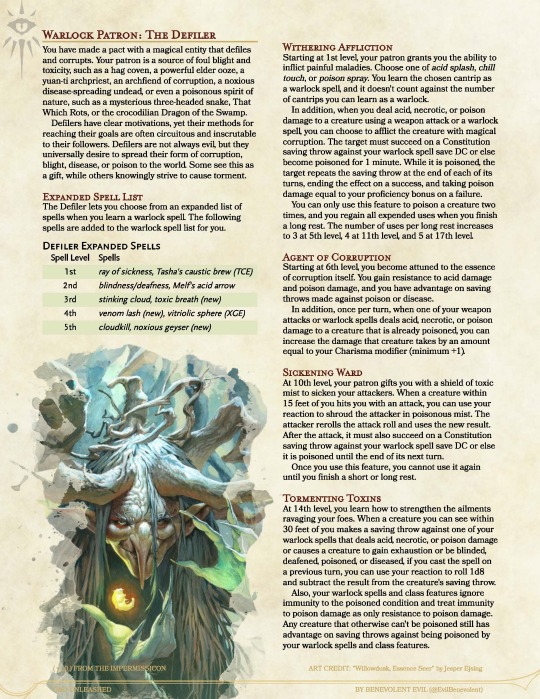
PDF Link | D&D Beyond Link
Spells: Toxic Breath, Venom Lash, Noxious Geyser
Of the many themes classically associated with witches and warlocks, poison and disease rank among the most popular, whether they’re distributing poisoned apples, using venomous beasts as familiars, spreading plagues and famines, or corrupting the very lands they lurk in. Now we have a warlock subclass that dives deep into those themes, one that works for hags, oozes, and any other kind of corrupting, poisonous, acidic, or disease-spreading entity: the Defiler patron!
If you lack access to Xanathar’s Guide to Everything or Tasha’s Cauldron of Everything, the new compendium will also provide a list of replacements for spells from those books which you can use in spell lists that reference them. For the Defiler Patron’s expanded spell list, you can use detect poison and disease in place of Tasha’s caustic brew, and you can use the new envenomed weapon spell instead of vitriolic sphere.
119 notes
·
View notes
Photo
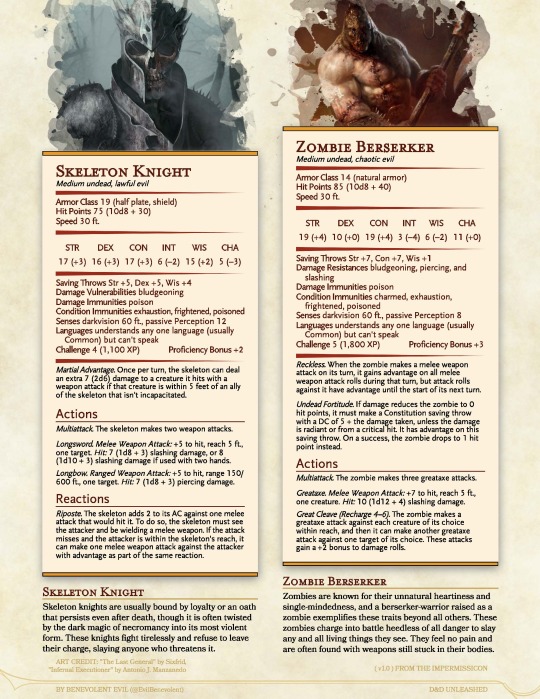
“The Queensguard have not abandoned their oaths to protect the ruined castle, even in death. They are still superb knights, and will not harm you if you display the Royal Insignia. But beware the undead butcher locked in the castle basement, for it has no such loyalties.”
PDF Link | D&D Beyond Links: Skeleton Knight, Zombie Berserker
These undead warriors provide DMs with ready-to-use stat-blocks for some more powerful undead that can threaten higher-level characters while still being weak enough to be the minions alongside a stronger enemy in an encounter. They won’t die to a single fireball, but they aren’t going to eclipse a stronger boss monster.
They also work well as minor bosses for lower-level characters: a lone skeleton knight guarding the party’s first magic sword or a ruthless zombie berserker prowling the halls of the first cultist dungeon they must defeat can be the perfect end to an adventure already themed around zombies or skeletons. For the rest of the undead warriors, such as the high-level ghost commander, you might have to wait for the release of The Impermissicon itself!
115 notes
·
View notes
Photo

PDF Link | D&D Beyond Links: Agonize, Bend Blood, Grim Terror
If you’ve been waiting for some mid-level hemomancy spells to go along with the lower-level blood spells and high-level blood spells we’ve shown already, then this preview should really get your blood pumping with excitement! Blood magic plays a major role in the themes of the upcoming D&D Unleashed compendium for forbidden magic and lore, The Impermissicon, including content that ranges from spells like these to subclasses, magic items, monsters, and even a prestige class themed around blood magic.
These spells share more in-common than just being blood magic; they’re also offensive spells that can incapacitate the caster’s enemies. The first is a single-target stunning spell that deals a bit of bonus damage to bleeding targets, while another is a frightening necromancy (just like cause fear at 1st-level, from Xanathar’s Guide to Everything) that often acts as an empowered form of the fear spell, and yet another allows a spellcaster to turn any creature with blood into a combat-puppet against their will in a style that will already be familiar to some. Let’s take a closer look at the design of these three new spells.
83 notes
·
View notes